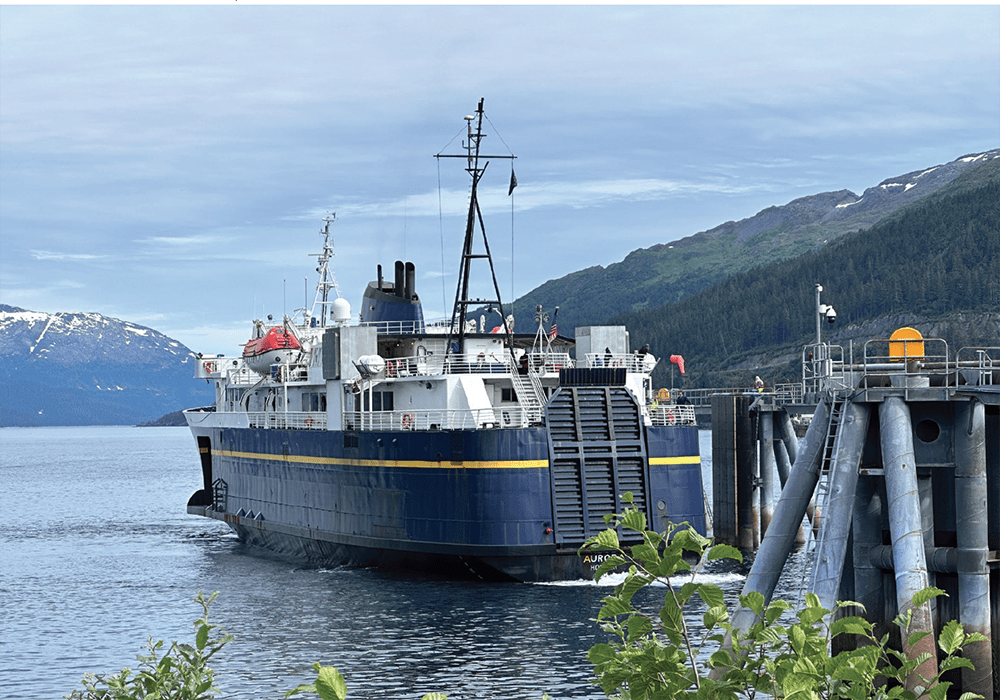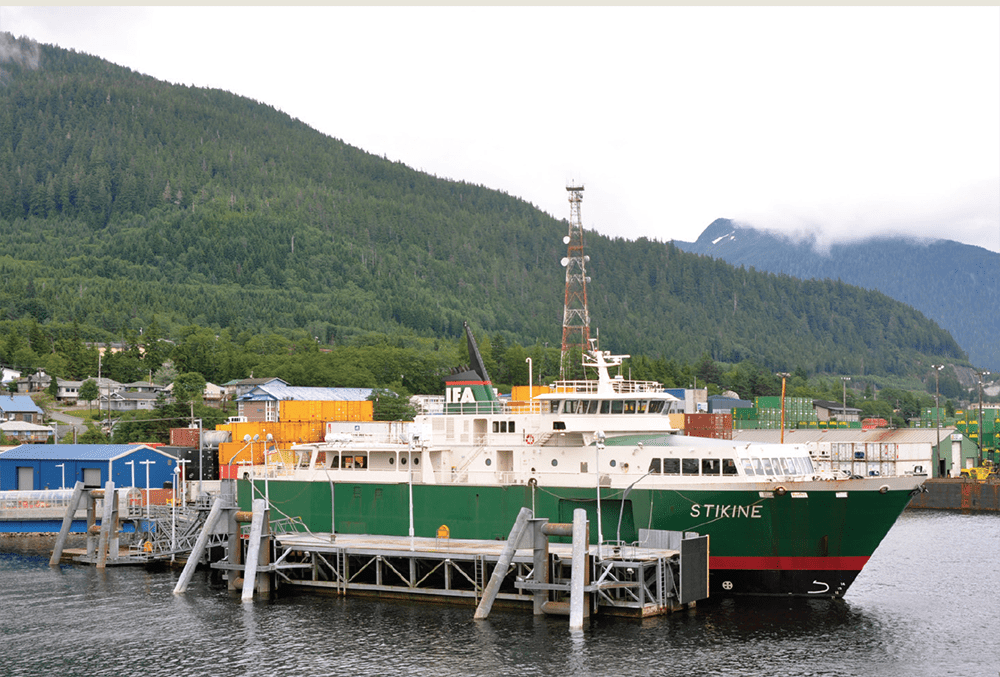Ferry travel to and within Alaska is provided by the state ferry system—the Alaska Marine Highway System (AMHS)—which serves Bellingham, WA, Prince Rupert, BC, and 33 coastal Alaska communities from Ketchikan to Unalaska.
The Marine Highway in Southeast Alaska follows the Inside Passage from Bellingham, WA, to Skagway, AK. The Southcentral/Southwest route serves Prince William Sound, Homer, Kodiak and the Aleutian Islands.
The Inside Passage used by the Alaska Marine Highway is the protected waterway between the islands and the mainland of both British Columbia and Southeast Alaska. Queen Charlotte Sound, at the northern tip of Vancouver Island, is the only exposure to Pacific swells for mariners on this route.
British Columbia Ferry Services, Inc. (BC Ferries) also serves the Inside Passage, providing passenger/vehicle ferry service between Port Hardy (Bear Cove) and Prince Rupert, BC. Port Hardy is located at the north end of Vancouver Island, 312 miles/502 km north of Victoria via Trans-Canada Highway 1 and BC Highway 19. Prince Rupert, the farthest north of the BC Ferries ports, connects to the Yellowhead Highway 16.
BC Ferries schedules, information and reservations for the Inside Passage, along with details on tariffs and vessels, appear under “BC Ferries” beginning on page 38 this section. Visit BC Ferries online at www.bcferries.com or phone 1-888-223-3779.
Motorists often use the Alaska Marine Highway, northbound or southbound, as an alternative to driving all of the Alaska High- way and its access routes. By using the Alaska Marine Highway System and/or BC Ferries, travelers can eliminate between 700 and 1,700 miles of highway driving, depending on their itinerary. The water route also allows travelers the opportunity to take in the magnificent scenery and picturesque communities located along the Inside Passage. Alaska-bound motorists should keep in mind that only 2 Inside Passage ports connect to the Alaska Highway: Haines, via the Haines Highway; and Skagway, via the South Klondike Highway.
Also providing passenger/vehicle ferry service within Alaska’s southeastern region is the Inter-Island Ferry Authority.
Alaska State Ferries
Ferry travel to and within Alaska is via the Alaska Marine Highway System (AMHS), which provides year-round transport to over 33 Alaska communities from the southern gateway cities of Bellingham, WA, and Prince Rupert, BC, to ports across Alaska. Many Alaska communities are inaccessible to road systems, making the sea travel option essential. This waterway route is so extraordinary it has been designated a National Scenic Byway and All-American Road; it is the only marine route with this designation.
This waterway route covers more than 3,500 miles through Southeast Alaska, Prince William Sound, the Kenai Peninsula, Kodiak Island, and the Aleutian Chain (see maps). The ferry system connects with the highway system in Bellingham, WA, and Prince Rupert, BC, and the Southeast Alaska communities of Haines and Skagway. Motorists often combine a ferry trip with their driving itinerary, which can save you hundreds of miles of driving, depending on your itinerary. The state ferry fleet provides passenger/vehicle ferry service in 3 regions: Southeast, Southcentral/Prince William Sound and Southcentral/Southwest.

The Alaska state ferry system has 2 seasons: May 1 to September 30 (summer), when sailings are most frequent; and October 1 to April 30 (fall/winter/spring), when service is less often. For trip planning and scheduling, please go to the AMHS website at www.ferryalaska.com. Email questions to AMHS at [email protected] or phone the central reservations office in Juneau at 1-800- 642-0066.
Reservations: Alaska state ferry travel is very popular in the summer. Walk-on passenger traffic is usually possible, even last-minute, but reservations are strongly recommended for travelers with a vehicle or wanting a cabin. Make reservations with AMHS online at www.ferryalaska.com, or by calling 1-800-642-0066, or through Viking Travel, phone 800-382-9229 or 907-772-3818, online at www.AlaskaFerry.com. Reservations for cabin space and for vehicles should be made as far in advance as possible to get the sailing dates you prefer. However, don’t assume a sailing is sold out if you suddenly decide to include the ferry in your itinerary; phone or check online to see if there is space available.
Vehicles: Vehicle fares depend on the size of your vehicle and the distance you travel. You are charged by how much space you take up, so a truck with trailer is measured from the front of the bumper to the end of the trailer, including hitch space. Charges are also applied to motorcycles, bikes and kayaks. Do not attempt to estimate your vehicle length; you must accurately measure your vehicle to avoid additional charges and the potential for being moved to a later sailing due to size restrictions. Maximum length allowed is 48 feet for a single unit. Some exceptions and/or restrictions apply to certain ports and vessels. Please visit www.ferryalaska.com or phone 1-800-642-0066 for more information. U.S. Coast Guard safety regulations prohibit travel on the car deck; passengers are not allowed to sleep or dine in their vehicles.
Cabins: If you are traveling on one of the longer ferry runs, such as the 38-hour trip between Bellingham, WA and Ketchikan, AK, you should reserve a cabin well in advance. Cabin fares are charged per unit, not by the number of people using the cabin. Cabins are outfitted with single or double bunk bed-style berths and vary in size and availability. Some cabins have a toilet, shower and linens (towel, sheets, blankets). Pick up keys from the purs- er’s office when you board. You can also rent blankets, pillows, and towels for a fee from the Purser on mainline vessels.
Other Sleep Options: If cabin space is sold out or you wish to save a few dollars and travel without a cabin, the inside recliner lounges and the covered solarium located on the upper deck serve as sleeping areas. Just bring your own sleeping bag and find yourself the perfect spot to relax for the evening. Small, free-standing tents are also permitted on the solarium deck (but not under the heated covered area) and on the stern of the cabin deck. Be sure to bring duct tape to secure your tent to the deck as strong winds can pick up while the ferry is underway.
Food & Beverage Service: Food ser- vice varies from vessel to vessel. Hot meals, snacks, and beverages are available in cafeterias or snack bars on all vessels, except the Lituya. Food service hours vary based on sailing departure times. You can bring your own food and beverages, but keep in mind that refrigeration is not available onboard. For guest convenience, there are microwaves (in the dining area) and coin-op ice and soft drink/snack vending machines.
Luggage: You are responsible for your own luggage. Foot passengers may bring up to 100 lbs. of hand luggage. There is no limit on weight carried in a vehicle. Baggage carts for carry-on luggage are driven between the terminals and the car deck. Baggage handling is NOT provided and the Alaska Marine High- way System is not responsible for lost, stolen, or damaged luggage.
Pets: For a pet to be transported via ferry between Bellingham, WA, and Prince Rupert, BC, and Alaska ports, they must have a valid rabies certificate and it must clearly identify your animal and be presented at check-in.
Dogs and other pets are not allowed in cabins and must be transported on the vehicle deck only. When prior approval has been obtained, there may an exception made for a certified service animal. Pets are to be transported inside a vehicle or in kennels (on the car deck) furnished by the passenger. Pets must be cared for by the owner. On long sailings, you may feed, water and/or walk your pet on the car deck during one of the 15-minute announced car deck calls. You may also walk your pet at port stops. Keep in mind that some port stops are very brief and that sailing time between some ports will be as long as 38 hours (Bellingham to Ketchikan). Car deck calls are dependent on weather conditions and other variables.

Accessibility: Each vessel has a few cabins equipped to accommodate passengers with disabilities and every vessel has elevator access to cabin decks.
Hazardous Materials: Hazardous materials may not be transported on the ferries. The valves on propane or similar type tanks must be turned off and sealed by an AMHS employee. Portable containers of fuel are permitted but must be stored with vessel personnel while en route.
ID Requirements: All AMHS customers are required to show proper valid government ID, meaning photo identification issued by a government authority such as a state or provincial driver’s license, passport, official government issued ID, or military ID. Passengers traveling in or out of Prince Rupert, BC, or who plan on driving through Canada, are required to show their passport. Passengers onboard AMHS vessels between Bellingham, WA, and Ketchikan, AK, are not required to show a passport as the ship does not stop in a Canadian port along the way.
Vessels
Columbia (COL) began service 1974; carries 499 passengers, 133 vehicles, 104 cabins; dining room, cafeteria, heated solarium.
Kennicott (KEN) began service 1998; car- ries 450 passengers, 78 vehicles, 109 cabins; cafeteria, heated solarium.
Matanuska (MAT), began service 1963; carries 450 passengers, 83 vehicles, 106 cabins; cafeteria, heated solarium.
Tustumena (TUS) began service 1964; carries 160 passengers, 34 vehicles, 24 cabins; dining room, heated solarium.
LeConte (LEC) began service 1974; 225 passengers, 33 vehicles; cafeteria, solarium.
Lituya (LIT) began service 2004; carries 125 passengers, 15 vehicles.
Tazlina, began service 2019 in Lynn Canal as a day boat. 300 passengers, 53 vehicles.
Aurora (AUR) began service 1977; carries 250 passengers, 33 vehicles; cafeteria, heated solarium.
Chenega (CHE), began service in 2005; carries 210 passengers, 31 vehicles.
Fairweather (FWX), began service in 2004; carries 210 passengers, 31 vehicles.
BC Ferries
BC Ferries provides year-round service on 26 routes throughout coastal British Columbia, with a fleet of 35 passenger- and vehicle carrying ferries. The ferry service of special interest to Alaska-bound travelers is the “Inside Passage” route between Port Hardy (on Vancouver Island) and Prince Rupert, and routes to Vancouver Island from mainland ports out of Vancouver, at Tsawwassen and Horseshoe Bay.
Inside Passage service from Port Hardy to Prince Rupert offers a convenient connection with the Alaska Marine Highway at Prince Rupert. Prince Rupert is located 450 miles/724km west of Prince George via the Yellowhead Highway (see description of Prince Rupert on starting on page 256 in the YELLOWHEAD HIGHWAY 16 section). Port Hardy is 312 miles/502 km north of Victoria via Trans-Canada Highway 1 and BC Highway 19. NOTE: BC Ferries departs from Port Hardy (Bear Cove) terminal, which is 6 miles from downtown Port Hardy.
Inside Passage summer service between Port Hardy and Prince Rupert is aboard the MV Northern Expedition, carrying 600 passengers and 130 vehicles. This ferry has an expanded range of cruise-ship-like food service options to include a fine dining buffet, a relaxed atmosphere grill/cafeteria, as well as solarium seating, a gift shop, lounge, children’s playroom, 55 modern staterooms, travel information and many other amenities.
Summer service on this route is during daylight hours, so cabins are not necessary for the 16-hour trip, although cabins are available for day-use or round-trip passengers. (Passengers cannot stay onboard while ferry is in dock due to Transport Canada Regulations.) The ferry goes up one day and comes back the next. (Winter sailings include an overnight aboard the Northern Adventure with fewer scheduled sailings than in summer.) Check-in time is 2 hours prior to departure.
Keep in mind that both the northbound and southbound Inside Passage sailings arrive at Prince Rupert and Port Hardy respectively at 11:30 p.m. By the time you drive off the ferry, it will be midnight. Local campgrounds in both Prince Rupert and Port Hardy will accommodate RV guests arriving at this late hour, but it is a good idea to call ahead for reservations and let them know you will be on the ferry.
Inside Passage travelers can extend their visit from Prince Rupert out to Haida Gwaii (formerly the Queen Charlotte Islands) via the MV Northern Adventure. BC Ferries provides 3 to 6 roundtrip sailings a week, depending on the season, to Skidegate on Graham Island in Haida Gwaii. Crossing time is about 8 hours 1-way.
Northbound travelers also have the option of taking BC Ferries’ Northern Sea Wolf in summer for direct service between Port Hardy and Bella Coola. Bella Coola is the western terminus of the Chilcotin Highway from Williams Lake. After taking this route one summer, The MILEPOST® field editor Judy Nadon described it as “an outstanding 10-hour cruise followed by an exceptional driving experience.”
To reach Vancouver Island, travelers may use the passenger and vehicle ferry service to Victoria out of Port Angeles, WA, available from Black Ball, or take BC Ferries passenger and vehicle service from Tsawwassen, south of Vancouver, to Swartz Bay.

Travelers may also take BC Ferries service from Tsawwassen to Duke Point/Nanaimo (2 hours) or from Horseshoe Bay, west of Vancouver, to Departure Bay/Nanaimo (1 hour and 40 minutes). Be aware that during commuting hours and on weekends and holidays, lines can be long. To avoid a sailing wait during popular travel times, book a reservation in advance for these routes by visiting www.bcferries.com. From Nanaimo it is 251 miles/405 km—or about a 5 hour drive—to Port Hardy, the departure point for BC Ferries Inside Passage service. If you are driving from Victoria to Port Hardy, allow at least 7 hours. Ferry routes connecting Vancouver and Vancouver Island are serviced by a modern fleet of ferries including the 2 largest Spirit Class, which were recently converted to operate on natural gas and are much cleaner for the environment.
Vancouver Island is a popular destination for vacationing mainland residents. Alaska-bound motorists taking the BC Ferries Inside Passage route should allow plenty of time in their itinerary to visit the island’s many attractions.
Schedules: BC Ferries Summer 2024 Inside Passage (Port Hardy–Bella Bella/ Klemtu–Prince Rupert) schedule appears on facing page. Sailing schedules for other months/ports are available online at www.bcferries.com. Travelers are advised to check the online schedule prior to traveling.
Tsawwassen–Swartz Bay, Horseshoe Bay– Departure Bay, and Tsawwassen–Duke Point ferries sail daily year-round, with frequent (only Tsawwassen–Swartz Bay is hourly in the summer) sailings from early morning to late evening during summer with naturalists onboard in summer. Schedules are available online only at www.bcferries.com.
Fares: Inside Passage peak (regular) season passenger fares are from May 1 to Oct 1. Shoulder and off-peak season rates are reduced. These lower fares are available during the fall, winter and spring when ser- vice is less frequent.
All fares shown are in Canadian funds. Terminals accept Visa, Mastercard, American Express or cash, but most terminals cannot accept debit cards (the exceptions are Port Hardy/Bear Cove and McLoughlin Bay, which can accept debit cards for payment).
At press time, Inside Passage regular pas- senger fares (in CAD) one-way to/from Port Hardy and Prince Rupert were: (peak/off peak) $188.55 regular/$110.70 adult passenger; $94.25 regular/$55.40 child, 5 to 11 years; under 5 years of age, free. (Special fares apply for BC residents on school events and for dis- abled and senior BC residents.) Vehicle fares one-way for vehicles up to 7 feet high, up to 20 feet in length: $429.70 regular/$241.35, plus an additional $36.65 regular/$20.60 for each extra foot over 20 feet. Other one-way fares: Motorcycle, $214.80 regular/$120.65 (with sidecar or trailer, $326.85 regu- lar/$176.10); stowage (canoe, kayak, etc.) $10.
Summer cabin rates for the Northern Expedition (pictured above) day-cruise between Port Hardy and Prince Rupert are: Inside cabins, $135; outside cabins, $160. To book a wheelchair-accessible cabin, phone 1-888- 223-3779.
Reservations: Passenger and vehicle (pri- vate passenger or recreational vehicle with or without a trailer) reservations are strongly advised for the Inside Passage. Reservations are less essential, but still recommended for the frequent Island to Vancouver routes. For reservations, phone 1-888-223-3779 in North America; phone 250-386-3431 from outside North America. Reservations can be made at www.bcferries.com. Cancellations made fewer than 30 days prior to departure for Inside Pas- sage trip are subject to a cancellation fee.
Information: BC Ferries phone in North America 1-888-223-3779; from out- side North America, phone 250-386-3431; email [email protected]; online at www.bcferries.com.



Comments are closed.